In this Case Report we analyze the possible causes of the poor health status of a professional Apis mellifera iberiensis apiary located in Gajanejos (Guadalajara, Spain). Several factors that potentially favor colony collapse were identified, including Nosema ceranae infection, alone or in combination with other factors (eg, BQCV and DWV infection), and the accumulation of acaricides commonly used to control Varroa destructor in the beebread (coumaphos and tau-fluvalinate). Based on the levels of residues, the average toxic unit estimated for the apiary, suggests a possible increase in vulnerability to infection by N. ceranae due to the presence of high levels of acaricides. These data highlight the importance of evaluating these factors in future monitoring programs, as well as the need to adopt adequate preventive measures as part of national and international welfare programs aimed at guaranteeing the health and fitness of bees.

